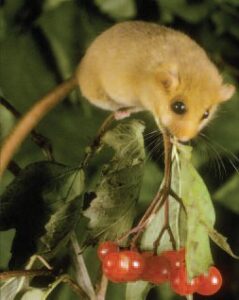Our Ecology Leads support Tilhill in the process of site appraisal, non-specialist scoping surveys and assessments for protected species and their habitats before any work starts on site. The field training follows on from the general protected species and habitat training that all Tilhill managers and supervisors receive.
Dormice are one of the most rare and endangered animals in the UK, they are fully protected under law. There are many threats to the Dormouse meaning its population has fallen almost 50% since 1995. These threats include climate change as we get warmer winters the normal hibernation pattern of dormice is disturbed, and dormice wake too early when there is little food available for them to forage.
Hazel Dormice are protected by law
It is a criminal offence to:
- Damage or destroy a breeding site or nesting place of dormouse.
- Deliberately kill or injure a dormouse or deliberately disturb a dormice.
What can we do?
Many of the woodlands and forests that we manage in Wales and Southern England are habitats to dormouse, we manage these woodlands and forests to the UK Forestry Standard and often under the UK Woodland Assurance Scheme. We will be managing these woodlands and forests with areas designated to biodiversity, linking habitats and keeping species rich areas for long term retention. Often our activities include traditional coppicing work particularly in areas of Southern England. As dormice have declined due to a reduction in these traditional forestry methods such as coppicing it is great to be involved in these habitat restoration and woodland management projects.
Where we are undertaking any work in woodlands and forest managers will complete initial appraisals to see if it is likely to be present. Where there is potential for their presence, they will commission specialist surveys develop work methods and plans to include protection of the hazel dormouse and its habitat.
Make sure you are clear on the areas which must be protected and control measures that must be put in place.
Always be alert to protected species on sites. Dormice are mainly found in the southern counties of England and much of Wales but they are also present in a few localities in the Lake District.
What to look for?
Dormice are rarely seen, being nocturnal and very secretive. They also hibernate in nests on the ground. The best way to evidence their presence is to look out for gnawed hazelnuts although this depends on fruiting hazel being present. Both nuts to the right have been eaten by dormice. Look out for a neat smooth circular cut to the inside of the opening and tiny radiating teeth marks on the outside. Woodmice also take hazelnuts and eat them in a similar way but the inside of the cut shell is not smooth.
You may also find their summer nests in brambles and low growing shrubs. Typically, nests are spherical, grapefruit sized and made from strips of honeysuckle bark and leaves.
Need help?
If you think you have seen evidence of dormice or a potential nest contact the Tilhill Manager immediately. They will arrange for a further survey and additional measures such as establishing a buffer zone.
Managers should contact one of our Ecology Leads, or the Safety and Assurance Team if they need further information on any aspects of protected species including pre- commencement checks, mitigation measures and licensing.





